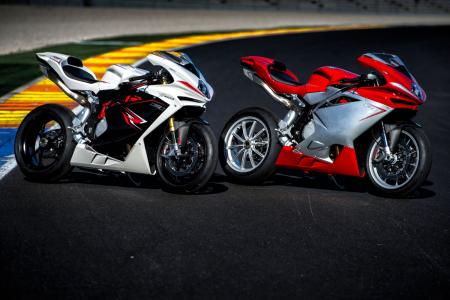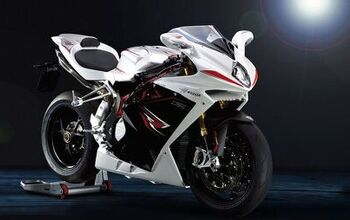2013 MV Agusta F4 and F4 RR Review - Motorcycle.com
The MV Agusta F4 carries its DNA all the way back to the F4 750 Oro of 1997. Sixteen years later MV has launched its most sophisticated F4 yet, the F4 RR. Here’s a superbike with a claimed 201 horsepower, a state-of-the-art electronics package and super exotic Ohlins electronically controlled suspension. The RR is no doubt dripping over with high tech, but the standard F4 isn’t bad either.
MV Agusta chose the technical and fast Ricardo Tormo circuit in Valencia for its introduction of the F4 MY13 range. The assembled moto press would get just four 20-minute sessions to evaluate both bikes. I kicked off my first session on the standard F4.
Thumbing the starter, the inline-Four growls to life with the sound of serious intentions exiting the four square organ pipes in the bike’s tail. The seat is very much racing and not exactly spacious. Knees are high up, clutching the 4.5-gallon fuel tank.
Immediately I notice the F4 is so eager to rev, which makes me wonder how frantic the F4 RR will be. I do my warm-up laps and start using more and more revs, of which there are plenty of. Above 9000 rpm the F4 is fury itself, and with 195 horsepower (claimed) on tap you get that familiar sensation of “How could anything be faster?”
The F4 must be ridden very fast to get the best of it, and in this early session I’m not quite up to the job yet. It feels stiff and too hard because I’m riding it like a sport-tourer. I need to shape up for my next session.
I chose the standard F4 again for my second session and I feel more determined to wrestle the best out of it this time. I’ve set the traction control to level 2 (of eight) which I feel is only a safety setting on this circuit with plenty of grip. Initially I still don’t feel fast enough to test traction control, but toward the end of the session I can’t tell if TC is working or if the Pirelli Diablo Supercorsa tires are still providing immense grip. Probably the latter.
The F4’s 998cc inline-Four is more flexible than ever and allows second gear to be used where first was needed before. The MV Agusta engineers have come up with a fine torque curve, which from 9600 rpm maintains 81.1 ft.-lb. all the way to the rev limiter at 13,600 rpm. Power delivery feels smooth below 9000 rpm, where it then rushes like mad. At 13,400 rpm the F4 develops 195 ponies, and with its claimed dry weight of 421 pounds, it feels very light underneath me.
At a standstill the F4 feels heavier and stiffer certainly compared to the Ducati Panigale and Aprilia RSV4 Factory, but at speed there can’t be much in it at all. Regardless, I’m left with a profound feeling that the F4 must be ridden fast.
For my third session, it’s F4 RR time. Amazingly, the growl at start-up sounds more evil than the standard F4, and I know I’m in for a treat. Here we have exclusive forged titanium con-rods with a 21% mass reduction compared to the F4 standard models.
The crankshaft is also forged, resulting in a 2% reduction in mass compared to the standard F4. Along with new more efficient (8mm to 10mm) oil lines and higher oil pressure, the engineers were been able to push the rev ceiling to 14,000 rpm, achieving a sky-high 201-hp figure (claimed) at 13,600 rpm. All this whilst maintaining an overall lower working temperature for the engine.
On the track 201 horsepower feels mental down the roughly half-mile straight. Inside my helmet I felt like I could rival a NASA space rocket when revs are above 10K.
The electronically assisted shift system is a great aid, but I did fail to kick properly up a gear a couple times so I’ll put a question mark on the sensitivity of the system. It’s probably a software issue that can be adjusted as the F4 RR is oh so adjustable (frame, pegs, etc). The EAS also enables clutchless downshifts but, naturally, not at 14K rpm. MV says the EAS reduces shifting times by 40%, equaling a 2.2-second faster lap using the same test rider.
Suspension on the F4 RR differs from the F4 and F4 R in one major area: the RR receives electronically controlled Ohlins bits. The F4 gets a Marzocchi 50mm fork and a Sachs rear shock whilst the F4 R features an Ohlins TTX rear shock to differ it from the F4 standard model. The standard but fully adjustable Marzocchi/Sachs setup works very fine, but the Ohlins equipment puts it in another ballpark.
The Ohlins EC features a TTX EC rear shock, an Ohlins EC NIX 43mm fork, and even an Ohlins EC steering damper. This allows the rider to use the riding modes to also adjust the suspension in a progressive manner, so the suspension follows vehicle speed. Enabling all this is an integrated Ohlins ECU connected to the F4 RR’s ECU.
MV Agusta has really gone out big time to blow our minds with the F4 RR which now equals the Ducati Panigale S in high tech. The Ohlins EC suspension is what dreams are made of out on the Valencia circuit. There’s sensitivity when you want it, and the suspension stiffens up when needed automatically and it’s also fully customizable in the dashboard for individual parameters.
With super lightweight forged aluminum wheels, the F4 RR (and F4 R) feels feather light when throwing it from ear to ear. That’s quite an achievement on an inline-Four with such a high rev ceiling. The faster you go the more brutal you have to be with it, and to save energy I found it perfectly acceptable to short shift from second to third as the power is always plentiful.
Tires are the eminent Diablo Supercorsa SPs from Pirelli in sizes 120/70-17 front and 200/55-17 rear, and they have more than enough grip to deal with the massive 201 horsepower of the RR. Traction control is without doubt needed to help cope with the massive power surge, and frankly, the F4 RR would be slightly too mad without it.
To stop this superbike MV Agusta has gone for the very best, employing the Brembo M50 radial calipers first seen on the Ducati 1199 Panigale. Meanwhile the F4 and F4 R make due with heavier M4 items. The RR also has a Brembo master pump that replaces the Nissin items. I could only feel a marginal difference between the two. In terms of weight, there are grams saved by using the M50s. They make slowing from 170 mph to 80 mph after the Valencia straight a piece of cake.
Tech Talk
In the press conference, Brian Gillen (3 & 4 Cylinder platform manager) stressed that it’s very difficult to produce 1500 F4 RR engines with 201 horsepower. To achieve this benchmark, pistons are hand-selected and the porting is done by hand.
The new Ride-by-Wire electronics package ensures that all 201 wild horses can be used effectively. A new Mikuni fuel pump with two injectors per cylinder can spray fuel at 3.5 bars rather than the previous 3.0. The fuel sensitivity now stretches to two Hall Effect sensors with three signals each for exact metering.
Conclusion
The F4 RR is the absolute MV Agusta flagship model and as such deserves a place as one of the very best motorcycles in the world. At $24,998 for the RR version, it’s not cheap, but for a very narrow expert/enthusiast, I think it’s worth every penny. Switch to the F4, saving a whopping $7500, and now we’re talking more mainstream and obtainable compared to the competition.
While incredibly exciting, the F4 is slightly harder and more difficult to ride fast than its top competitors and only marginally more desirable than the Aprilia and Ducati. I love the engine improvements and how it feels at full throttle.
Whilst the prices for the F4s are quite lofty, the bike’s high levels of fit and finish make it seem almost like it’s hand built, particularly on the RR model. But I could easily ignore its 201-hp figure and go for the more affordably priced standard F4 to own such a thing of beauty.
Related Reading
2013 MV Agusta F3 675 Street Review
2013 MV Agusta F3 675 Review - Video
2012 Aprilia RSV4 Factory APRC vs. 2012 MV Agusta F4RR Corsacorta - Video
2012 MV Agusta F4RR Corsacorta Review
2012 MV Agusta Brutale 675 Review
2012 MV Agusta Brutale R 1090 Review
2012 MV Agusta F3 675 Review
2012 Ducati 1199 Panigale Review - Video
More by Tor Sagen








































Comments
Join the conversation